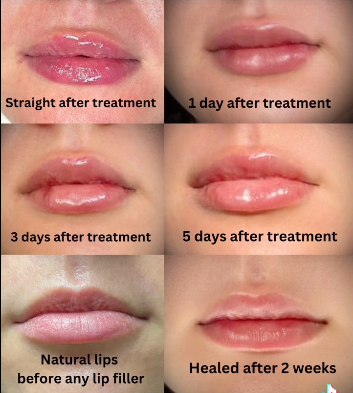










There’s no denying the allure of a beautiful pair of lips, especially when enhanced with the magic touch of non-surgical lip fillers.
Put simply, lip fillers are delicate injections, designed to enhance the lips. This procedure is the hottest trend and incredibly sought after by men and women of all ages.
Generally, dermal fillers are used on various locations of the face to enhance target areas and minimize fine lines and wrinkles. The same fillers can be used for the lips—your injector will personalize the exact treatment based on your desired results.
For example, if you want a more prominent Cupid’s bow, you will be given fillers along your lip line edges. In contrast, going after an overall plumper look means getting injections in different parts of your lower and upper lips. The specifics of the procedure will differ depending on your aesthetic goals, such as balancing lip proportions, sharpening the contours, or increasing overall volume.
Now, you might be wondering about the actual process of getting lip fillers. The journey typically begins with an in-depth consultation with our experienced cosmetic doctors. Once you agree on a tailor-made lip filler treatment, we apply a numbing cream to the lips to lessen discomfort. Then, using an expert injection technique, lip filler injections are carefully administered to the upper and lower lip, resulting in instant lip augmentation.

Both men and women should learn about what happens after getting lip fillers.
It’s normal for you to have swelling, redness, and lip filler bruising. But, if you take good care of your lips after the filler, the healing process will go faster.
Day 1: You’ll notice lots of swelling after your initial lip filler appointment. Lips have been injected multiple times with a needle, and the body responds by swelling to bring increased blood supply to the area in order to heal. Hyaluronic acid filler attracts water, bringing more swelling to tissue spaces within the lips. Remember to not exercise for 24 to 48 hours post-filler, as exercise will cause more swelling in the lips. For activity, we advise a light walk.
Days 2-4: MORE swelling! You’ll likely be the most swollen during Day 2 and Day 3 of the lip filler healing journey. The morning after lip filler you may think, “What have I done?!” Don’t worry, the swelling subsides! Your lips may even feel firm, lumpy, and look unnatural. They should not be painful, but they may be a little sore.
Days 5-7: Lip swelling is starting to subside, and at this point, you’ll probably start to enjoy the looks of your lips.
By the second week, your body starts adjusting to the fillers, and the swelling should start to go down.
Day 8-14: Continuing Healthy Practices to Reduce Swelling After Lip Fillers
Continuing to stay well-hydrated is crucial. Avoid alcohol as it can exacerbate swelling. Also, try to avoid strenuous exercise for at least a week post-procedure. Exertion can increase blood flow to the area, leading to increased swelling. While light activities are okay, try to rest as much as possible.
Swelling is a normal part of the lip filler procedure – and any dermal filler or medical procedure. Your immune system reacts to trauma or perceived threats.
When something damages the body (even minimal damage caused by a small needle injection) your immune system sends increased fluid and white blood cells to the injured area, which causes it to swell.
This increased blood flow causes redness and heat. Your nerves may also send warning signs to the brain in the form of pain or sensitivity to the area, which results in you treating the area with more care.
You can notice pain and swelling in almost any injury, treatment, or cosmetic procedure. People who get tattoos often have to wait a few days for the swelling to go down. If you get a papercut, your finger may be sensitive for a few hours after. The same goes for a stubbed toe. Swelling after lip filler injections is expected and will subside over time.
Although swelling is a common and expected occurrence after getting lip fillers, there are practical ways to manage and minimise it effectively. Here are some helpful tips:
Applying an ice pack or cold compress to your lips intermittently can benefit you significantly. Doing so every few hours post-treatment for the first few days can lessen inflammation and reduce swelling. Remember not to apply the ice directly on your lips; use a cloth or fabric as a barrier.
Heavy physical activity can lead to elevated blood pressure and increased blood flow, which can, in turn, exacerbate swelling. It is advisable to rest and refrain from any strenuous exercise for the first few days after the procedure.
Keeping your head elevated, particularly during sleep, can reduce swelling. This posture takes advantage of gravity to pull fluid away from the lips and reduce swelling.
Drinking plenty of water and staying well-hydrated can help reduce swelling. On the other hand, consuming too much salt can cause your body to retain moisture, increasing swelling in the lips. Limiting salt in your diet can aid in maintaining a fluid balance and potentially reduce lip swelling.
Certain medications and supplements have blood-thinning properties that can increase bruising and swelling. Consult your doctor about your prescription, and seek advice tailored to your needs.